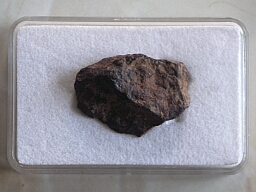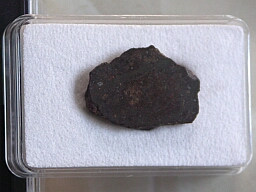













This is a rather different picture gallery from the others in these pages, as the images are of objects I can touch rather than just see. The meteorites shown here are, of course, fragments I have purchased rather than found but are indeed the real thing: actual pieces of many of the heavenly bodies I have observed through the telescope and camera. Those with printed backgrounds can be obtained from a number of outlets but the larger pieces are somewhat harder to come by - I got mine from SpaceRocksUK. For purposes of comparison, note that all the display boxes are the same size (55mm x 35mm or approx 21/4" x 11/2").
My primary astronomical targets are the planets, and so it was natural that I should have started my collection with fragments from these bodies. Planetary meteorites are also much rarer than those consisting of "cosmic debris", and so are a little more interesting from a collecting point of view. Those below are typical of their types, and reflect the fact that meteorites emanating from asteroid Vesta are, perhaps surprisingly, the most commonly encountered.
On the printed backgrounds and the descriptions below, "NWA" stands for "North-West Africa", the place where they were either found or purchased. Almost all meteorites are found here or in Antarctica, but this does not mean they don't fall elsewhere: it's just that they are so much easier to see against a light sandy surface or on snow than against grass or soil. Numbers and weights of types of meteorite given below are taken from The Meteoritical Society Bulletin Database in late February 2012. Information given in the links may differ though, as web-pages are not always kept up-to-date. When assessing the relative rarity of a class of meteorite, bear in mind that the Database contains over 54,000 entries!
To see an enlarged or close-up view of each meteorite, click or tap on the image (and again to restore the original view).
 |  |
| Angrite meteorites are exceedingly rare! In fact only 19 examples are known, weighing in total just 28.9kg, of which 16.55kg was in one stone! (The rest weighed from to 0.6g to 2.71kg). NWA2999 itself was found in 2004 and weighed 392g (about half the average weight if the very large stone is excluded). This sample is thus quite a large one, comparatively speaking. Moreover, NWA2999 is a very unusual member of this small class of meteorites, with characteristics suggestive of an origin in a planetary body - quite possibly Mercury. For further information, click on the following links:- | Lunar meteorites are much more common than angrites, with 154 found so far comprising a total weight of 61.5kg. As with angrites, much of this was in three stones (of 13.5kg, 11.53kg and 5.53kg), with the rest ranging from 0.8g to 1.649kg (average=205g). NWA4881 was found in 2005 and weighed 606g so was considerably heavier than average (it's in fact the 18th heaviest, including the "Top 3"). It is thought to have come from the same incoming body as NWA3163, 4483 & 6275: together they weigh 2.449kg. For further information, click on the following links:- |
 |  |
| This meteorite has similarities to NWA2999 but has a slightly different composition, called brachinite. There are 32 known brachinite (or "brachinite-like") meteorites, with a total weight of just 23.0kg. The four largest (4.82kg, 4kg, 3.1kg & 3kg) account for most of this, while the others range from 4.1g to 1.5kg (average=287g). NWA6077 was found in 2008 and at 1.01kg is the sixth heaviest brachinite. It is probably from the same incoming body as NWA5400, and possibly others. Its composition and structure indicates it was formed within a planetary body, with suggestions that this might have been the very early Earth (before the formation of the Moon). For further information, click on the following links:- | Martian meteorites are between angrites and lunar for rarity, with 104 found so far. Due to several very large stones (of 18kg, 13.71kg and eight greater than 3kg), the total weight is 108.77kg. The remaining 94 stones range from 5.3g to 1.65kg (average=293g). NWA4925 was found in 2007 and at 282g is almost exactly "average". It is one of the 87 shergottite meteorites (a type of basalt, named after the large example found in Shergotty, India, in 1865). Most of the rest (13 of them) are nakhlite, named after the find in Nakhla, Egypt, in 1911. Martian meteorites are very much younger than other types (about 1 billion years, compared to the 4.5 billion for Vesta-types and 2.8 billion for lunar-types), indicating they formed on a parent body which retained volcanic activity for much longer i.e. a planet. For further information, click on the following links:- |
 |  |
| There are three fundamentally different types of meteorite from Vesta - Howardite, Eucrite and Diogenite - as shown on the diagram. Diogenites were formed deep within the parent body and tend to be just one type of mineral, Eucrites were formed much nearer the surface and consist of a mixture of minerals, and Howardites are an amalgam of the other two types, thought to have been formed during the impact which liberated them from Vesta. This is a fragment from the famous 25kg Bilanga meteorite, which was actually seen falling on 27th October 1999 - it is classified as Diogenite. The dark portion is the fused crust of the meteorite, formed during Bilanga's fiery journey to Earth: to get a fusion crust on a sample this small is most unusual. The interior of the meteorite can be seen to be a pale grey colour. For more information, click on the following links:- | |
 |  |
| These images show the two sides of the same fragment, from the famous Tatahouine meteorite which fell in Tunisia in 1931. It is also classified as diogenite, but it is in a crystalline form as opposed to the "rocky" form of Bilanga. The dominant mineral, orthopyroxene, gives the fragment its characteristic pale green/grey colour. Diogenite meteorites are not particularly rare - 243 are known (of various sub-types), weighing from a massive 40.3kg down to 0.9g - so I haven't added up a total weight. The Tatahouine meteorite is unusual in that it exploded at low altitude and so consists entirely of fragments. As originally collected it weighed 12kg, making it the fifth heaviest diogenite meteorite, but more fragments were found at later dates. This sample is an unusually large piece: 2.9g. For further information, click on the following links:- | |
 |  |
| As with the Tatahouine meteorite above, these images show the two sides of the same fragment of a Vesta meteorite, from NWA6392. It is once again classified as diogenite, but a "brecciated diogenite" (i.e. made of grains) rather than the crystalline form of Tatahouine. It thus looks totally different, rather more like the angrite and brachinite types (compare the close-up views). This sample is also different in that one side of it shows the original surface - the close-up shows this to be smoothly contoured, characteristic of an object which has undergone surface melting. The rusty appearance is due to oxidation of the iron content of the meteorite after it landed on the Earth. As originally collected it was in 34 pieces, weighing a total of 503g, but more fragments were found at later dates to take it up to 1318g. This sample weighs a respectable 4.1g. For further information, click on the following links:- | |
 |  |
| Although it does not look like it, this image is also of the NWA6392 sample! It is taken at an angle, to allow reflected light to show its internal structure. The "veins" appear to be metallic, but are in fact where melted rock has been squeezed between the grains due to the extreme temperatures and pressures caused by the impact event which created the meteorite body. To see a similar effect in another specimen, click on the following link:- | This is a completely different type of Vesta meteorite, known as eucrite. Eucrites come from the crust of Vesta and are much more common than diogenites, with 604 definitely-classified examples known (of various sub-types), weighing from a staggering 330kg right down to a mere 0.23g. This sample is from NWA6668, found in 2010 and weighing 261g. For more information, click on the following links:- |
 |  |
| Here we have the third type of Vesta meteorite, Howardite, from NWA2696. Weighing 6572g, this meteorite (and several others) is thought to be associated with NWA1929: it certainly looks very much like the picture of it in link 2, below. NWA2629 resembles eucrite as it is mainly composed of this type of rock - 72% eucrite to 14% diogenite, in fact. Howardite is about as numerous as diogenite, with 222 formally-classified specimens known. The largest by far weighs 18.8kg but then they range from 2.95kg to 0.5g. The images show the two sides of my 4.55g fragment, the melted original outer surface (seen very well on the close-up) contrasting with the detail shown by the smoothly-polished cut inner surface. For more information, click on the following links:- | |